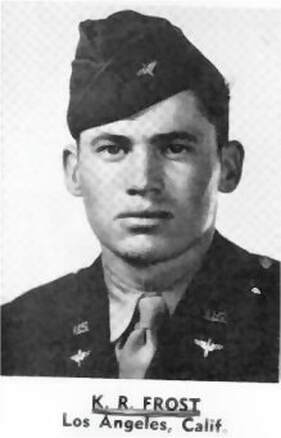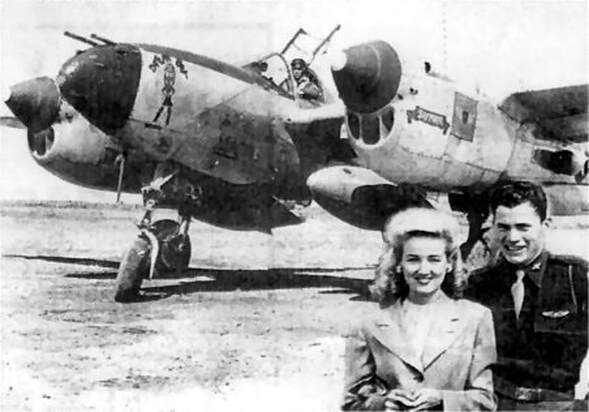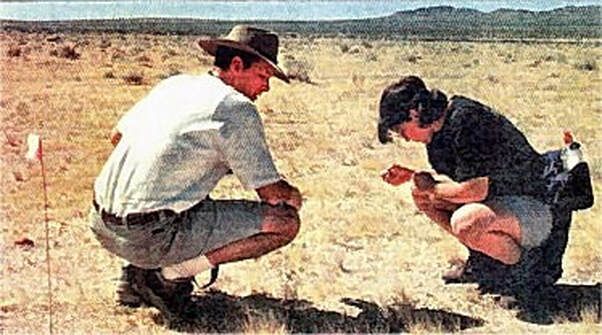Kenneth R. Frost
Submitted by, Charles C. Walker/95th - Friend
Photos from the 9/22/98, Desert Dispatch
Submitted by, Charles C. Walker/95th - Friend
Photos from the 9/22/98, Desert Dispatch
Williams Field - Class 44A
Betty Tucker and Lt. Kenneth R. Frost in front of Frost's P-38, the 'Batlin Bet'
P-38L sin 44-24492 17 SEP 45 30 miles northeast of Daggett CA
Last January AAIR was contacted by Thomas Van Stein with a request for an accident report for Lt. Kenneth Frost, who was killed in a P-38 in a stateside accident in 1945. Thomas related the story of his mother and Lt. Frost, who were dating prior to Lt. Frost being sent to Italy where he served with the 15th AF, 82nd FG. Lt. Frost had painted a caricature of Thomas' mom on his P-38 and named it Battlin' Bette after her. Lt. Frost returned from Italy where he had damaged a German aircraft in the air and destroyed another on the
ground. Lt. Frost was awarded the DFC for one of the missions he led in Italy, but the paper work was still going through "channels" when Lt. Frost was killed and his father received it for him four months after his death. Back Stateside Lt. Frost started instructing at Daggett AAF in CA with the 444th Base Unit. Just two weeks before his training unit was decommissioned, Lt. Frost was killed in an accident during gunnery training. Many years later, Thomas found pictures of the P-38 with his mother's name on the nose and began to investigate, taking him through many years of research, eventually coming to AAIR to obtain the official accident report. After locating and reviewing the accident report, I told Thomas that I felt that there was a good possibility that we could locate Lt. Frost's crash site. Thomas contacted Major Barry Johnson, the NTC & Ft. Irwin Public Affairs Officer, who was extremely helpful in securing
permission to go out onto the gunnery range. On September 18, the day after the 53rd anniversary of Lt. Frost's crash, AAIR (Heidi and Craig Fuller) met up with Thomas Van Stein and Steve Blake, an aviation historian and author, and drove up the Fort Irwin where we were met by Major Johnson. On the base we were joined by Dr. Mark Allen, base archaeologist, and David Drudge, a reporter from the Desert Dispatch, which is the Barstow CA paper. Lt. Frost's brother, Hal Frost, was also supposed to join us, but due to health problems was unable to make it. Using the photos in the accident report to locate the area of the crash, we immediately identified the location of the target Lt. Frost had made a rocket run on. From the report we knew that his wing dug into the ground 200 yards past the target. After playing with the crash report photos we fanned out and soon started finding aircraft debris. After a while of searching I finally recognized two parts as being typical of a P-38. Marking the debris with flags as we went, we were able to determine the path of the aircraft after it hit. We eventually found four separate part numbers that confirmed the crash was a P-38. We were also able to exactly match the report photos. The style of the debris trail also confirmed it was Lt. Frost's accident. We located the main bum
area where the range crew had pulled Lt. Frost's body from the wreckage (though unfortunately too late). There was even a parachute buckle on top of the surface. It was a moving sight for the group as we all took a moment to silently relive in our minds the events that had occurred so long ago. In all I would estimate there was only 5 to 10 pounds remaining of the 12,780 lb. aircraft. It had most likely been cleaned up shortly after the accident or during a range cleaning operation. There are currently two dirt roads that cut through
the wreckage. The base archaeologist is going to send in a CA archaeological site record and register the site with the SHPO (State Historic Preservation Office). He will also make sure that base activities don't do any further damage to the site. I would like to thank Fort Irwin and especially Major Barry Johnson and Dr. Mark Allen for their help. site was identified by Lockheed inspection the pen for scale. stamps and P-38 part numbers on parts like this.
ground. Lt. Frost was awarded the DFC for one of the missions he led in Italy, but the paper work was still going through "channels" when Lt. Frost was killed and his father received it for him four months after his death. Back Stateside Lt. Frost started instructing at Daggett AAF in CA with the 444th Base Unit. Just two weeks before his training unit was decommissioned, Lt. Frost was killed in an accident during gunnery training. Many years later, Thomas found pictures of the P-38 with his mother's name on the nose and began to investigate, taking him through many years of research, eventually coming to AAIR to obtain the official accident report. After locating and reviewing the accident report, I told Thomas that I felt that there was a good possibility that we could locate Lt. Frost's crash site. Thomas contacted Major Barry Johnson, the NTC & Ft. Irwin Public Affairs Officer, who was extremely helpful in securing
permission to go out onto the gunnery range. On September 18, the day after the 53rd anniversary of Lt. Frost's crash, AAIR (Heidi and Craig Fuller) met up with Thomas Van Stein and Steve Blake, an aviation historian and author, and drove up the Fort Irwin where we were met by Major Johnson. On the base we were joined by Dr. Mark Allen, base archaeologist, and David Drudge, a reporter from the Desert Dispatch, which is the Barstow CA paper. Lt. Frost's brother, Hal Frost, was also supposed to join us, but due to health problems was unable to make it. Using the photos in the accident report to locate the area of the crash, we immediately identified the location of the target Lt. Frost had made a rocket run on. From the report we knew that his wing dug into the ground 200 yards past the target. After playing with the crash report photos we fanned out and soon started finding aircraft debris. After a while of searching I finally recognized two parts as being typical of a P-38. Marking the debris with flags as we went, we were able to determine the path of the aircraft after it hit. We eventually found four separate part numbers that confirmed the crash was a P-38. We were also able to exactly match the report photos. The style of the debris trail also confirmed it was Lt. Frost's accident. We located the main bum
area where the range crew had pulled Lt. Frost's body from the wreckage (though unfortunately too late). There was even a parachute buckle on top of the surface. It was a moving sight for the group as we all took a moment to silently relive in our minds the events that had occurred so long ago. In all I would estimate there was only 5 to 10 pounds remaining of the 12,780 lb. aircraft. It had most likely been cleaned up shortly after the accident or during a range cleaning operation. There are currently two dirt roads that cut through
the wreckage. The base archaeologist is going to send in a CA archaeological site record and register the site with the SHPO (State Historic Preservation Office). He will also make sure that base activities don't do any further damage to the site. I would like to thank Fort Irwin and especially Major Barry Johnson and Dr. Mark Allen for their help. site was identified by Lockheed inspection the pen for scale. stamps and P-38 part numbers on parts like this.


